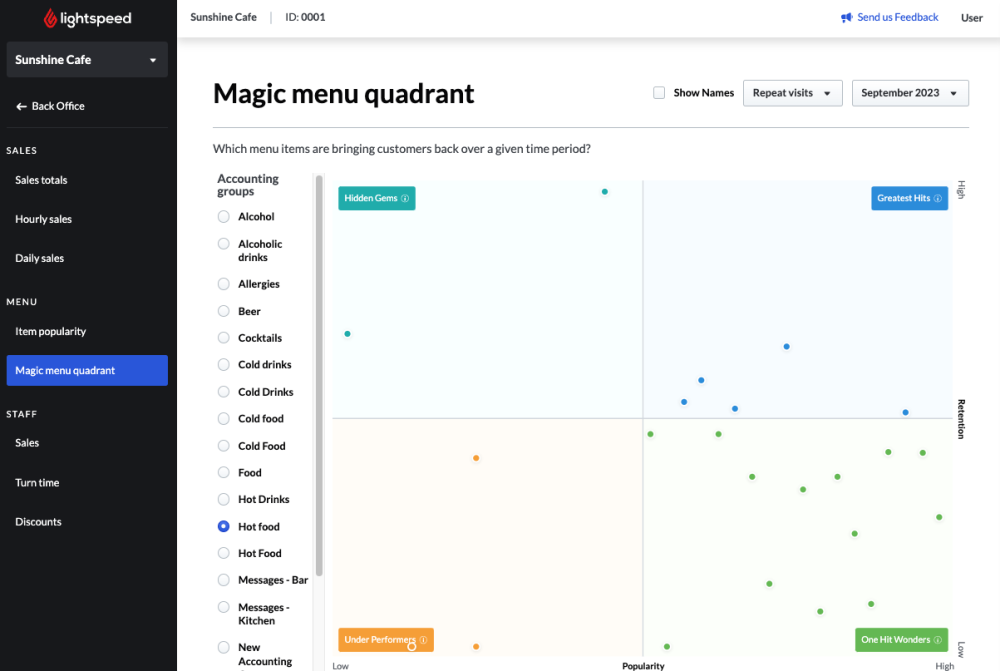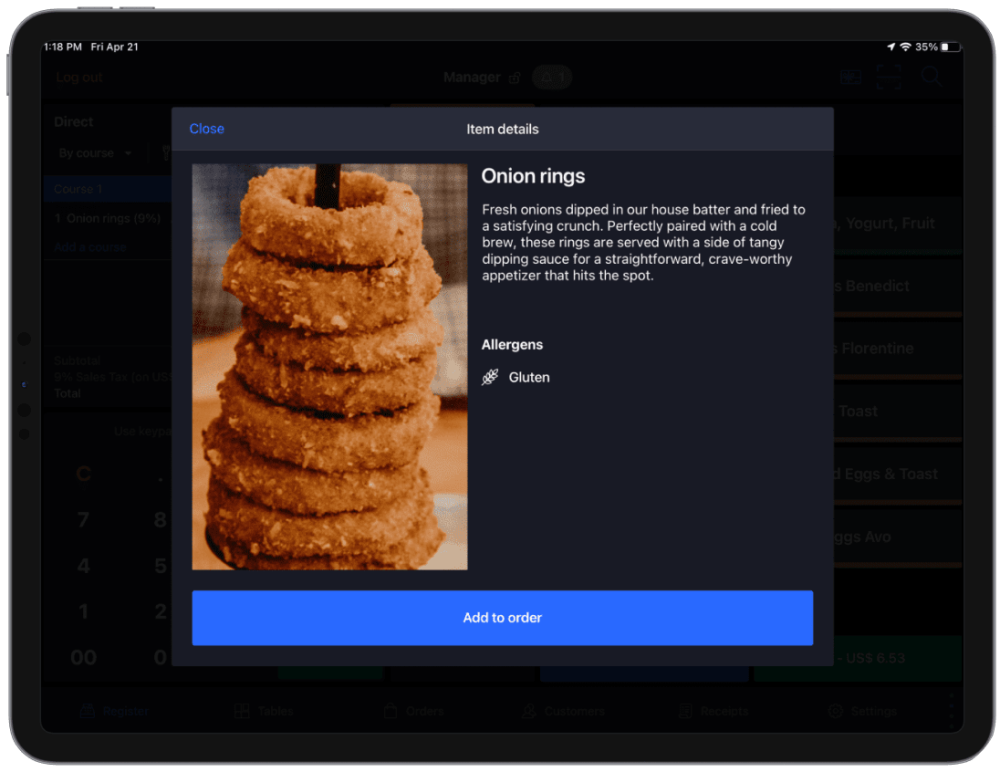
Let’s be honest. Many restaurant managers put more effort into managing the front of house (FOH) because it’s the public face of the business. But the success of your restaurant isn’t about one side or the other. The front and back of house have to work together to provide the best customer experience possible.
As a restaurant owner or manager, you need to do everything within your power to bring the front and back of house together as one cohesive unit. It’s vital that your employees on both sides understand this and act accordingly.
Keep reading for tips and strategies on how to manage the front and back of house.
- Front of house vs back of house positions
- Managing the back of house
- Managing the front of house
- Addressing conflicts between the FOH & FOH
- Preventing and resolving conflicts between the FOH & BOH
- Improving communication between the FOH & BOH
Front of house vs back of house positions
Front of house (FOH) positions involve direct interaction with customers. Some key positions in the front of house include:
- host/hostess
- server
- bartender
- busser
- food runner
- sommelier
Back of house positions deal with the action behind the scenes, like food prep, cooking and washing dishes. Some key back of house positions include:
- chef
- sous chef
- line cook
- prep cook
- expeditors
- dishwashers
| Back of house (BOH) | Front of house (FOH) | |
| Primary focus | Food preparation and kitchen management | Customer service and dining experience |
| Key roles | Chefs, cooks, dishwashers, food prep staff, kitchen managers | Servers, hosts/hostesses, bartenders, floor managers |
| Skills required | Culinary skills, time management, inventory management | Customer service, communication, sales |
| Customer interaction | Minimal to none | High |
| Work environment | Kitchen, storage areas | Dining room, bar, entrance |
| Main responsibilities | Cooking, food prep, cleaning and sanitizing, inventory management | Greeting/seating customers, taking orders, serving food, taking payments |
| Challenges | High-pressure environment, tight timelines, quality control, inventory control | Dealing with customer complaints, maintaining service quality, coordination between teams |
Best practices for managing the back of house
Managing the back of house (BOH) centers on kitchen operations, food quality and efficiency.
To ensure smooth operations in the back of house, your kitchen layout needs to be optimized for efficiency, with equipment and workstations that are strategically placed to minimize unnecessary movement. Learn more about commercial kitchen layouts.
Conduct regular training
Regular training on culinary techniques and kitchen protocols improve speed and consistency. Take the time to work alongside newer cooks and show them how you want things done, without micromanaging too much. As a manager, make sure you know the menu inside and out—be willing to jump in as expo, on food prep, in the dish pit or wherever you can help (without hindering) your back of house crew.
Cross train whenever possible—a more versatile back of house staff will give you more flexibility and really helps when people call out sick. People also get burnt out faster if they’re constantly put at stations they don’t like or that don’t challenge them.
Use a KDS
A Kitchen Display System (KDS) helps restaurants to manage their kitchens better. Integrated with your restaurant POS, a KDS can provide real-time information about orders, help improve food preparation accuracy and efficiency and enhance communication between the front and back of house.
Streamline inventory management
Track and automate inventory management with a centralized system that helps you accurately predict your needs, so you’re not running out of ingredients or ordering more than you need. Not only will your back of house run more smoothly, you’ll be able to reduce waste and maintain a healthy COGS ratio.
Cultivate a healthy workplace culture
Encouraging a culture of teamwork and continuous feedback can lead to process improvements, making the kitchen more adaptable and resilient. Scheduling regular maintenance for kitchen equipment minimizes downtime and helps prevent unnecessary frustration and stress behind the line.
These steps, combined with a focus on quality control and customer satisfaction, will help you create a streamlined and efficient back of house.
Best practices for managing the FOH
Managing the front of house (FOH) focuses on guest interaction, ambiance and service. Here are some best practices to effectively oversee your FOH staff.
Implement data-driven practices
To ensure efficient service in the front of house, comprehensive and regular training is essential. With data and insights, you can elevate product knowledge and skills across your entire front of house team so you can ensure a consistent guest experience and make the most of every cover.
Using Advanced Insights, you can track and compare performance metrics like product sales and turn times to better understand individual employee’s strengths and weaknesses. For example:
- Compare sales and tip averages to identify your top performers.
- Compare turn times and average checks to find out who may need coaching on efficient table management.
- Track discounts, voids, and sales across categories to identify your product experts, and identify and correct knowledge gaps.
- Identify product experts who can mentor and upskill less experienced staff.
Menu insights can also help you improve recommendations and encourage upselling by giving servers insights into what guests want and what keeps them coming back. Armed with good data, your front of house staff can make better, more confident recommendations.

Data and insights can also help you optimize your schedule, enabling you to accurately forecast your staffing needs, so you’re never understaffed—which leads to burnout and bad service—or overstaffed, which hurts your employees’ earning potential. With an integrated employee management tool, you can even automate your weekly schedule—learn how this Toronto Speakeasy uses an integrated solution to save $400-500 a week on labor.
Be accessible to your FOH staff
When managing the front of house, it’s important to be on the lookout for who needs help and to stay easily accessible to the staff at all times. Communicate whenever you need to step away, even if it’s just for a few minutes. If your dining room or bar is slammed, be willing to help out wherever needed, being mindful not to get in the way.
Equip your team with the right tools
Ensure your front of house team has the technology and tools they need to provide fast, efficient service. This includes an easy-to-use, intuitive restaurant POS and fast, portable payment terminals. A handheld POS and payments solution can help you streamline your front of house workflows and eliminate service bottlenecks.
Promote good workplace culture
Fostering good workplace culture and recognition also motivates staff to maintain high service standards. These strategies combined will help you ensure smooth and efficient service, maintain service standards and keep your front of house team happy and engaged.
Address conflicts between the FOH & BOH
Common sources of conflict between the front and back of house
Conflicts between back and front of house employees are typically caused by breakdowns in communication and/or a lack of understanding of each department’s roles and challenges.
Front of house staff may feel frustrated if they feel like the kitchen is too slow, or if they’re fielding lots of customer complaints about over or undercooked food or food being served cold. As tipped employees, these perceived “slip ups” in the back of house directly impact their earnings.
Front of house employees may also complain about the back of house being rude or “shooting the messenger”—when food gets sent back, front of house staff often have to deal with both an unhappy customer and an angry chef who’s not pleased about having to remake the meal on the fly.
Back of house employees, on the other hand, frequently complain about the front of house stacking their tickets—punching in all their orders at once so the kitchen gets slammed. When they’re crazy busy, interruptions from the front of house can throw off the flow and ruin efficiency behind the line—whether that’s questions about allergens or needing something made on the fly.
“Line cooking done well is a beautiful thing to watch. It’s a high-speed collaboration resembling, at its best, ballet or modern dance.” — Anthony Bourdain
Furthermore, because they’re dealing with the public, the front of house can be impatient, which can translate to unrealistic expectations on the back of house. And then nothing is worse than watching plates die in the window because nobody’s running food.
Besides that, working the line is an intense job and the conditions aren’t great at the best of times. It’s always hot, there’s a lot of pressure, working with cuts and burns is common, and the hours are long for less money than front of house employees take home (with tips).
Both sides tend to feel that they are under more pressure than the other. Addressing these issues requires open communication, mutual respect and a clear understanding of each other’s challenges.
Prevent and resolve conflicts between the FOH & BOH
Focus on teamwork during onboarding
Yes, it’s important that new hires learn the standard operating procedures of your restaurant, but don’t forget to take the time to address the importance of teamwork between the front and back of house, and your expectations in terms of how they will cooperate to get the job done.
It’s important to understand where conflicts between the front and back of house frequently occur so you can develop your onboarding training to prevent them. For example, if your kitchen staff has had it up to here with servers stacking their tickets, be sure to cover how to properly stagger orders during front of house onboarding.
Swap places for a day
You know what they say: “before you criticize someone, walk a mile in their shoes.” If your front and back of house are having a hard time seeing eye to eye, consider having employees switch jobs for a shift.
Of course, the goal is to increase empathy, not to self-destruct. Choose positions that won’t turn service upside down. For example, have a server take over the salad/cold food station on a busy lunch shift so they can experience the fast pace, intense heat and high pressure behind the line without burning guests’ food or themselves.
Have a back of house team member shadow one of your servers on the floor, or pour wine and beer at the bar on a busy Friday night. They’ll leave with a better understanding of what it’s like to juggle a million demands and potentially deal with unhappy customers while having to keep a smile on their face.
Spend low-stakes time together
The simple act of spending time together outside of a busy service can have a profound effect on the relationship between your front and back of house employees.
You could start doing staff meals—or “family meals”—as both a perk and a team building opportunity, or simply offer a free drink/meal to employees after their shift and let your teams find common ground while unwinding at the bar.
By creating opportunities for your back and front of house to connect when the pressure is off, you can facilitate better collaboration between your teams.
Share tips
Tip sharing boosts teamwork by ensuring that all staff, from servers to kitchen staff, are recognized for their contribution to customer satisfaction.
In this system, all employees are incentivized to work towards the common goal of exceptional service, leading to a more unified and motivated team. It also helps to minimize the wage gap which so often results in bad blood and an us vs them mentality between the back and front of house.
That said, implementing tip sharing in your restaurant isn’t without its challenges, including employee buy-in from the front of house and the administrative burden of managing tip outs (and its associated tax implications). Many employee management softwares enable restaurateurs to automate managing their tip pool. We definitely recommend checking them out.
Different regions also have different laws regarding tip sharing—you’ll want to make sure you understand the tipping rules and regulations that apply to your business.
TL;DR if you have the legal right to do so, creating an equitable tip sharing system takes time and effort, but the benefits to morale and employee engagement can be well worth it—not to mention a boon to your back of house recruitment efforts.
Improve communication between the BOH & FOH
Effective communication between the front and back of house is crucial. When your teams are playing broken telephone, the customer experience suffers and so does your bottom line.
Centralize information and share often
To improve communication between the front and back of house in a restaurant, implement regular briefings and debriefings to ensure everyone is on the same page about daily specials, ingredient changes and guest feedback.
Don’t forget about your managers and supervisors—it can be hard and time consuming to collect and keep track of everything they need to know for a successful shift. Consider simplifying the process with reporting automation.

Establish clear communication channels and protocols from the outset, and regular training sessions that emphasize teamwork and mutual respect.
Encourage staff to provide feedback and suggestions for improvement so you can handle potential issues proactively before they escalate into conflicts.
Leverage technology that connects your front and back of house
Use a modern point of sale platform that enables you to communicate updates in real-time, helping reduce misunderstandings and wait times and the frustrations that can throw staff into the weeds. For example, when you 86 an item in Lightspeed, your front of house can no longer order it. That means:
- No more chasing servers down to update them one by one
- No more returning to the table to tell a guest they can’t have what they ordered
Improving communication between your front and back of house helps to foster a cohesive team environment, improving service quality and customer satisfaction.
Eliminate gatekeeping of critical information
We highly recommend supplying your front of house team with easily accessible information about the ingredients and potential allergens in each dish. That could be as simple as a binder of your recipes—that is not locked in the office but is readily available at all times—or better yet, a handheld point of sale that displays allergen information at the touch of a button.

This way, your front of house team can confidently and autonomously take care of guests’ dietary needs without having to ask the chef and disrupt the kitchen when they’re « dans le jus ».
Run your restaurant like clockwork
Effective restaurant management requires understanding the unique challenges and dynamics of both the front and back of house, and fostering communication and teamwork across all areas of the business. Regular staff meetings, comprehensive training and innovative technology can bridge the gap between your teams.
Want to learn how technology can help your restaurant level up today? Talk to one of our experts.
FAQs
What is a BOH position?
The back of house (BOH) generally refers to a restaurant’s kitchen operations, but it also includes any tasks that happen behind-the-scenes, out of sight of the customer. Some key back of house positions include executive chef, sous chef, line cooks, prep cooks, expeditors and dishwashers.
Is food runner back of house?
Food runners are often considered a hybrid between the back and front of house, but technically, because they are tipped (or tipped out, really) and have customer contact, they are actually part of the front of house.
Is housekeeping back of the house?
Housekeeping is considered one of the back of house positions, as housekeeping staff generally carry out their duties behind closed doors, or outside of the restaurant’s operating hours.
What is a front of house job?
Front of house (FOH) positions are roles that involve direct interaction with customers, specifically providing a welcoming and satisfying dining experience. Key front of house roles include host/hostess, servers, bartenders, bussers, food runners and sommeliers.
What is the difference between front of the house and back of the house employees?
Front of house (FOH) employees are the face of a restaurant. They interact directly with customers and are focused on the overall dining experience. Back of house (BOH) employees work behind the scenes, primarily in the kitchen, and are responsible for food preparation, cooking and maintaining health standards. Both sides are equally important to a restaurant’s success.

News you care about. Tips you can use.
Everything your business needs to grow, delivered straight to your inbox.


